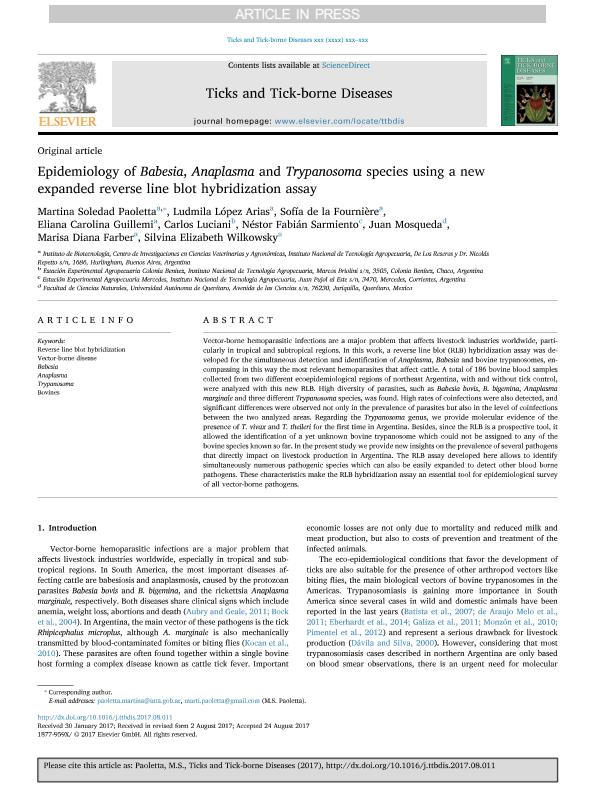Mostrar el registro sencillo del ítem
dc.contributor.author
Paoletta, Martina Soledad

dc.contributor.author
López Arias, Ludmila Sol

dc.contributor.author
de la Fourniere, Sofía Ana María

dc.contributor.author
Guillemi, Eliana Carolina

dc.contributor.author
Luciani, Carlos
dc.contributor.author
Sarmiento, Nestor Fabian

dc.contributor.author
Mosqueda, Juan
dc.contributor.author
Farber, Marisa Diana

dc.contributor.author
Wilkowsky, Silvina Elizabeth

dc.date.available
2018-04-06T15:31:55Z
dc.date.issued
2017-09
dc.identifier.citation
Paoletta, Martina Soledad; López Arias, Ludmila Sol; de la Fourniere, Sofía Ana María; Guillemi, Eliana Carolina; Luciani, Carlos; et al.; Epidemiology of Babesia , Anaplasma and Trypanosoma species using a new expanded reverse line blot hybridization assay; Elsevier; Ticks and Tick-borne Diseases; 9; 2; 9-2017; 155-163
dc.identifier.issn
1877-959X
dc.identifier.uri
http://hdl.handle.net/11336/41115
dc.description.abstract
Vector-borne hemoparasitic infections are a major problem that affects livestock industries worldwide, particularlyin tropical and subtropical regions. In this work, a reverse line blot (RLB) hybridization assay was developedfor the simultaneous detection and identification of Anaplasma, Babesia and bovine trypanosomes, encompassingin this way the most relevant hemoparasites that affect cattle. A total of 186 bovine blood samplescollected from two different ecoepidemiological regions of northeast Argentina, with and without tick control,were analyzed with this new RLB. High diversity of parasites, such as Babesia bovis, B. bigemina, Anaplasmamarginale and three different Trypanosoma species, was found. High rates of coinfections were also detected, andsignificant differences were observed not only in the prevalence of parasites but also in the level of coinfectionsbetween the two analyzed areas. Regarding the Trypanosoma genus, we provide molecular evidence of thepresence of T. vivax and T. theileri for the first time in Argentina. Besides, since the RLB is a prospective tool, itallowed the identification of a yet unknown bovine trypanosome which could not be assigned to any of thebovine species known so far. In the present study we provide new insights on the prevalence of several pathogensthat directly impact on livestock production in Argentina. The RLB assay developed here allows to identifysimultaneously numerous pathogenic species which can also be easily expanded to detect other blood bornepathogens. These characteristics make the RLB hybridization assay an essential tool for epidemiological surveyof all vector-borne pathogens.
dc.format
application/pdf
dc.language.iso
eng
dc.publisher
Elsevier

dc.rights
info:eu-repo/semantics/openAccess
dc.rights.uri
https://creativecommons.org/licenses/by-nc-sa/2.5/ar/
dc.subject
Reverse Line Blothybridization
dc.subject
Vector-Borne Disease
dc.subject
Babesia
dc.subject
Anaplasma
dc.subject
Trypanosoma
dc.subject
Bovines
dc.subject.classification
Otras Ciencias Biológicas

dc.subject.classification
Ciencias Biológicas

dc.subject.classification
CIENCIAS NATURALES Y EXACTAS

dc.title
Epidemiology of Babesia , Anaplasma and Trypanosoma species using a new expanded reverse line blot hybridization assay
dc.type
info:eu-repo/semantics/article
dc.type
info:ar-repo/semantics/artículo
dc.type
info:eu-repo/semantics/publishedVersion
dc.date.updated
2018-04-06T13:54:07Z
dc.journal.volume
9
dc.journal.number
2
dc.journal.pagination
155-163
dc.journal.pais
Estados Unidos

dc.journal.ciudad
Hoboken
dc.description.fil
Fil: Paoletta, Martina Soledad. Instituto Nacional de Tecnología Agropecuaria. Centro de Investigación en Ciencias Veterinarias y Agronómicas. Instituto de Biotecnología; Argentina
dc.description.fil
Fil: López Arias, Ludmila Sol. Instituto Nacional de Tecnología Agropecuaria. Centro de Investigación en Ciencias Veterinarias y Agronómicas. Instituto de Biotecnología; Argentina. Consejo Nacional de Investigaciones Científicas y Técnicas; Argentina
dc.description.fil
Fil: de la Fourniere, Sofía Ana María. Instituto Nacional de Tecnología Agropecuaria. Centro de Investigación en Ciencias Veterinarias y Agronómicas. Instituto de Biotecnología; Argentina. Consejo Nacional de Investigaciones Científicas y Técnicas; Argentina
dc.description.fil
Fil: Guillemi, Eliana Carolina. Consejo Nacional de Investigaciones Científicas y Técnicas; Argentina. Instituto Nacional de Tecnología Agropecuaria. Centro de Investigación en Ciencias Veterinarias y Agronómicas. Instituto de Biotecnología; Argentina
dc.description.fil
Fil: Luciani, Carlos. Instituto Nacional de Tecnología Agropecuaria. Centro Regional Chaco-Formosa. Estación Experimental Agropecuaria Colonia Benítez; Argentina
dc.description.fil
Fil: Sarmiento, Nestor Fabian. Instituto Nacional de Tecnología Agropecuaria. Centro Regional Corrientes. Estación Experimental Agropecuaria Mercedes; Argentina
dc.description.fil
Fil: Mosqueda, Juan. Universidad Autónoma de Querétaro; México
dc.description.fil
Fil: Farber, Marisa Diana. Consejo Nacional de Investigaciones Científicas y Técnicas; Argentina. Instituto Nacional de Tecnología Agropecuaria. Centro de Investigación en Ciencias Veterinarias y Agronómicas. Instituto de Biotecnología; Argentina
dc.description.fil
Fil: Wilkowsky, Silvina Elizabeth. Consejo Nacional de Investigaciones Científicas y Técnicas; Argentina. Instituto Nacional de Tecnología Agropecuaria. Centro de Investigación en Ciencias Veterinarias y Agronómicas. Instituto de Biotecnología; Argentina
dc.journal.title
Ticks and Tick-borne Diseases
dc.relation.alternativeid
info:eu-repo/semantics/altIdentifier/url/http://linkinghub.elsevier.com/retrieve/pii/S1877959X17300407
dc.relation.alternativeid
info:eu-repo/semantics/altIdentifier/doi/http://dx.doi.org/10.1016/j.ttbdis.2017.08.011
Archivos asociados
